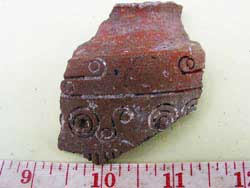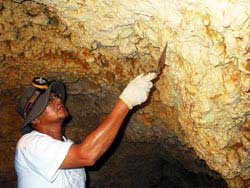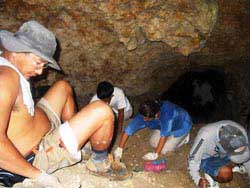|

|
|
This
potsherd found in a cave in Maitum, Sarangani, may be 3000 years
old. Jun Ramos,
Sarangani Fotos |
MAITUM, Sarangani -- A cave located seven kilometers from the
town hall here has yielded potsherds from various periods,
including those that are likely 3000 years old, archaeologists
from the National Museum who visited the site here, said.
But treasure diggers have heavily disturbed the caved,
rendering it very difficult, if not impossible, for archaeologists
to reconstruct that era in the prehistory not only of Mindanao and
the Philippines but also of Southeast Asia.
Dr. Eusebio Dizon and Prof. Rey Santiago of the National
Museum, who conducted preliminary studies at the cave in Sitio
Linao, Barangay Kiambing for two days last week, were dismayed to
see the damage wrought on the cave by treasure diggers. No
complete pot was found, only shards.
Dizon said 90% of the cave was heavily disturbed.
"Na-disappoint ako. (I am disappointed). We cannot even establish
the function of the cave," he told a forum attended by town
officials last Thursday.
Old-time residents in the area said the cave has seven
chambers, the farther part of which reportedly had drawings on the
walls, but the National Museum Team, including this reporter,
managed to reach only three as the entrance to the other chambers
had been blocked by sandbags and timber, the original cave floor
already covered several meters high with limestone from the tunnel
diggings.
 |
|
| Among
the potsherds found in the cave in Barangay Kiambing. Samples of the
shards would be sent abroad by the National Museum for precise dating. Jun Ramos,
Sarangani Fotos |
Dizon said it would have been best if the cave had not been
disturbed so the exact positions of the artifacts and their
associated materials could be studied "otherwise, they will become
useless pieces for scientific archaeological study."
Dizon, Curator I of the Archaeology Division and Head of the
Underwater Archaeology Section of the National Museum and Director
of the Archaeological Studies Program (ASP) of the University of
the Philippines, headed the archaeological team 11 years ago of
the now famous anthropomorphic secondary burial jars in Pinol
Cave, also in Maitum town. The team included Santiago, Museum
Researcher II at the National Museum who also teaches at the ASP.
The "Maitum Jars," as they are referred to now, are
"unparalleled in Southeast Asia" in that it is an exceptional
archaeological assemblage. The nearly 2000-year old
anthropomorphic jars of Maitum, bearing radiocarbon dates of "1930
plus or minus 50 BP (calibrated date of 5 BC to AD 225) and 1830
plus or minus 60 BP (calibrated date of AD 70 to 370)," are unique
in that "they are like portraits of distinct individuals, of
specific dead persons whose remains they guard," Dizon and
Santiago said in their book, "Faces from Maitum." ('Maitum
Jars' story in 'More News.')
Dizon, who was sent a photograph of two shards taken from
outside the Linao cave in late September, told MindaNews that they
were "probably much much older than the Maitum anthropomorphic
pots" and "appear to have been from the Late New Stone period,
from at least 3000 years ago."
|

|
|
Dr.
Eusebio Dizon, curator 1 at the National Museum and head of the
Archaeological Studies Program of the University of the Philippines. Jun Ramos,
Sarangani Fotos |
Dizon said that based on his research on the pictures sent, the
shards have "similarities with some of the Sabah pots from Bukit
Tengkorak, where I based my date of 3000 BP. or 1000 BC."
"But of course they may have been earlier or later than this
date. The Maitum pots are only 5 BC to 350 AD," he said.
"But we need more archaeological context and datable samples
from them," he said.
At the end of the two-day visit at the cave here, Dizon said it
appears like the yield from the cave cut across several periods,
some of them earlier than the Maitum Jars, the others much later.
He told the forum at the municipal gym last Thursday that the
shards depicting sketches of people (main photo above) could be older than the Maitum
Jars because the latter were already portraits done in clay of
individual persons while the former were still sketches of people.
Dizon added there is no evidence as yet of the presence of
anthropomorphic pots or that the cave is a burial site like Pinol
Cave was, but the cave in Linao may likely have been a ritual
site.
Dizon said samples of shards will have to be sent abroad to get a more
precise dating.
 |
|
|
Dr. Eusebio Dizon (left), led a
team last week to do a preliminary study on the cave in Barangay
Kiambing, Matium town which yielded shards from various periods,
including those likely to be 3000 years old. Jun Ramos,
Sarangani Fotos |
The shards were discovered last month when Mayor George Yabes,
who had been pushing for a municipal museum to house some of the
artifacts from the Pinol Cave, sent geologists to look around town
for clay samples that would be best for a ceramics livelihood
project.
The shards were shown to Serafin Ramos, Jr., Sarangani
provincial information officer, who sought the assistance of
MindaNews and social anthropologist Fr. Albert Alejo to send
photographs of the shards to Dizon. MindaNews and Alejo joined a
municipal team visit to the cave on October 8, collected more
shards and sent Dizon yet another set of photographs of shards,
including incised pieces, which could have belonged to the Early
Metal Age.
Dizon's team brought to the National Museum several plastic
bags of shards collected by the municipal team outside the cave
and the shards dug inside the cave by Dizon, Santiago, ASP
graduate student Eliza Romualdez-Valtos, a team from Maitum town
and this reporter.
Dizon also urged Yabes and other officials to continue
protecting Pinol Cave, the Linao cave and other caves in town
because "the cave is not the place for Yamashita gold hunters but
our own gold in terms of our heritage." Yabes vowed to ensure the
caves would be protected.
Dizon said the best that can be done about the cave in Linao is
to continue to protect it and to continue collecting whatever
shards can still be found so they can be studied and dated.
The team also hopes a complete pot can be reconstructed from
among the shards collected.